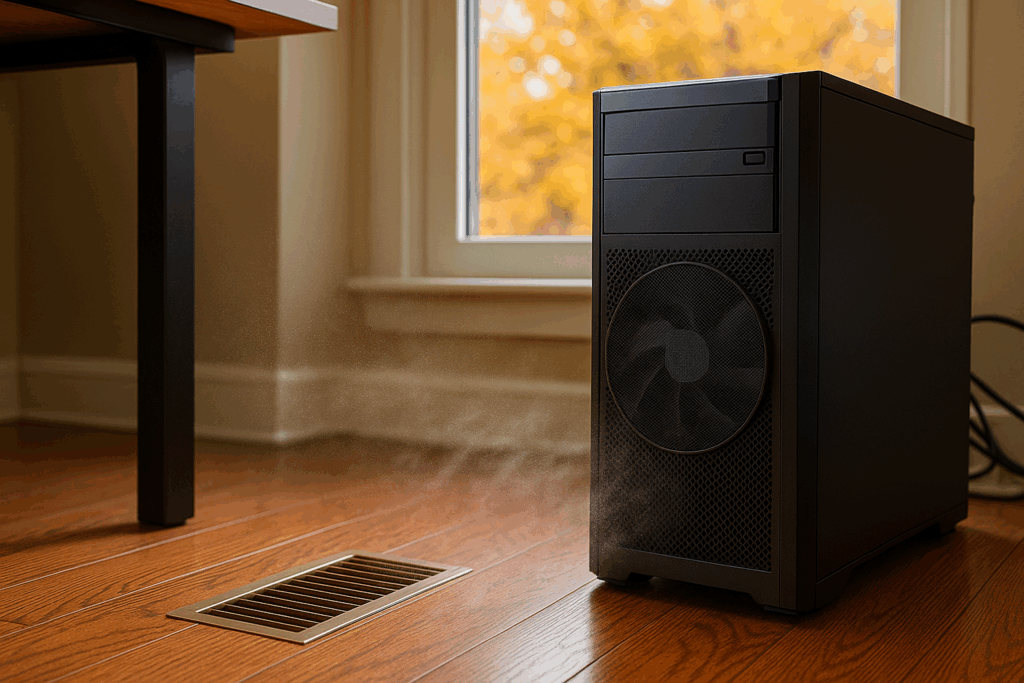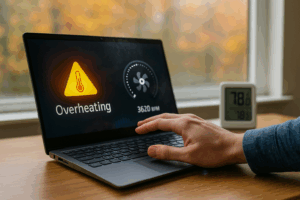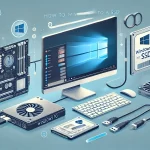Milwaukee Fall Tune-Up: Keep Your Computer Cool, Quiet, and Fast
As summer fades and the windows close, many Milwaukee homes flip on the heat. That change stirs up dust, traps warm air indoors, and—surprise—your computer can run hotter in the fall than it did in July. Left unchecked, heat shortens component life, throttles performance, and can even trigger sudden shutdowns.
At PCRuns, we help neighbors across Milwaukee keep their desktops and laptops cool and reliable. Here’s how to stop seasonal overheating before it stops you.
Why PCs Overheat More in Fall (Even Though It’s Cooler Outside)

Heating-season dust gets pulled straight into PC intake fans.
- Dust surge from heating systems: The first furnace cycles blow dust into rooms—and into your PC’s vents and fans.
- Stale indoor air: Closed windows reduce circulation. Warm, still air around your PC raises internal temps.
- Heavier workloads: School projects, remote work, gaming, and holiday photo/video backups all ramp up compute and heat.
- Clogged cooling paths: After a humid summer, dust mixes with lint/pet hair and mats onto heat sinks and filters.
Result: fans spin harder, performance dips, and parts wear faster.
Clear Signs Your Computer Is Running Too Hot
Overheating often hides in plain sight—watch for these early red flags:

Loud fans and on-screen warnings are the early signs of thermal trouble.
- Chassis feels hot—especially near vents or the laptop’s underside
- Fans roar or whine constantly
- Apps stutter, freeze, or take forever to open
- Random shutdowns or reboots (thermal protection kicking in)
- In games or video calls, frames drop and the system “lags” under load
If you’re seeing any of these, tackle it now—heat damage compounds over time.
The Fall Cooling Checklist (Do This Once, Then Monthly Quick Checks)
- Blow out dust (safely).
- Power off and unplug. For laptops, shut down fully.
- Use short bursts of compressed air at vents/fans; keep the can upright.
- For desktops: remove the side panel and blow through fans, heat sinks, PSU grilles, and case filters.
- Give it breathing room.
- Keep at least 2–3 inches of clearance on all sides.
- Don’t park a tower under a desk against a wall or in a closed cabinet.
- Avoid soft surfaces (beds/couches) that block laptop intakes.
- Stabilize the surface.
- Use a cooling pad for laptops.
- Make sure desktop case feet are intact so bottom vents can pull air.
- Tidy cables and dust zones.
- Bundle cords; remove clutter around intakes.
- Add a small room fan if your office is a warm, enclosed nook.
- Update and monitor.
- Install OS/driver updates (they often include power/thermal fixes).
- Use a light monitor (e.g., built-in Task Manager/Activity Monitor) to spot runaway apps.
- Consider a thermal refresh.
- If your system is 3–5 years old, thermal paste may be dry. Replacing it restores heat transfer.
Smart Upgrades That Lower Heat (and Boost Speed)
- SSD upgrade: Replacing a spinning hard drive reduces heat and noise while dramatically improving responsiveness.
- More RAM: Less swapping = less CPU stress and heat.
- New fans/filters: Modern PWM case fans are quieter and move more air; dust filters are cheap and effective.
- Laptop repaste + pad service: Professional disassembly, heat sink cleaning, and premium paste can drop temps by 5–15°C.
Not sure what you need? PCRuns offers free diagnostics and a clear repair-or-replace recommendation before any work.
Milwaukee-Specific Tips
- Basements & radiators: Basements harbor dust and moisture; radiators create hot pockets. Keep towers off the floor and away from heat sources.
- Pet hair season: As pets grow winter coats, intake grilles clog faster. Add a quick weekly vent check.
- Humidifiers: Great for comfort, rough on electronics if placed too close—avoid aiming moist air at your PC.
When a Professional Tune-Up Makes Sense
DIY cleaning helps—until it doesn’t. Call PCRuns if you notice:
- Temps stay high after cleaning
- Fans rattle or grind
- The system throttles during light tasks
- Laptops get too hot to touch, or you’re not comfortable opening the case
What we do in a Fall Tune-Up:
- Deep dust removal (inside fans, heat sinks, power supply, and filters)
- Thermal paste service for CPU/GPU (as needed)
- Fan testing and replacement if bearings are failing
- Airflow optimization (intake/exhaust balance, cable management)
- Storage, RAM, and health checks to catch issues early
Fast turnaround, transparent pricing, and practical advice—repair or upgrade only if it’s worth it.
Quick FAQs
Q: Is it safe to vacuum my PC?
A: No—vacuums can create static. Use compressed air and anti-static care, or let us handle it.
Q: How often should I clean fans/vents?
A: Light dusting monthly; deeper clean every 6–12 months (more often with pets or carpeted offices).
Q: My laptop is always hot on Zoom—normal?
A: Video encoding is CPU/GPU heavy. A cooling pad, app updates, and a thermal refresh can help a lot.
Q: Will an SSD really run cooler?
A: Yes. SSDs draw less power and produce less heat than spinning drives—plus they’re much faster.
Don’t Let Fall Heat Up Your PC
Make fall maintenance part of your routine—just like changing furnace filters. Preventing heat problems now is far cheaper than replacing a fried motherboard later.
📍 Milwaukee & nearby? Bring your computer to PCRuns for a Fall Cooling Tune-Up.
We’ll clean it, optimize airflow, refresh thermal materials if needed, and recommend only the upgrades that deliver real value.
👉 Ready when you are: Contact PCRuns and ask for the Fall Overheating Check-Up.
Related Posts:





Leave a Reply